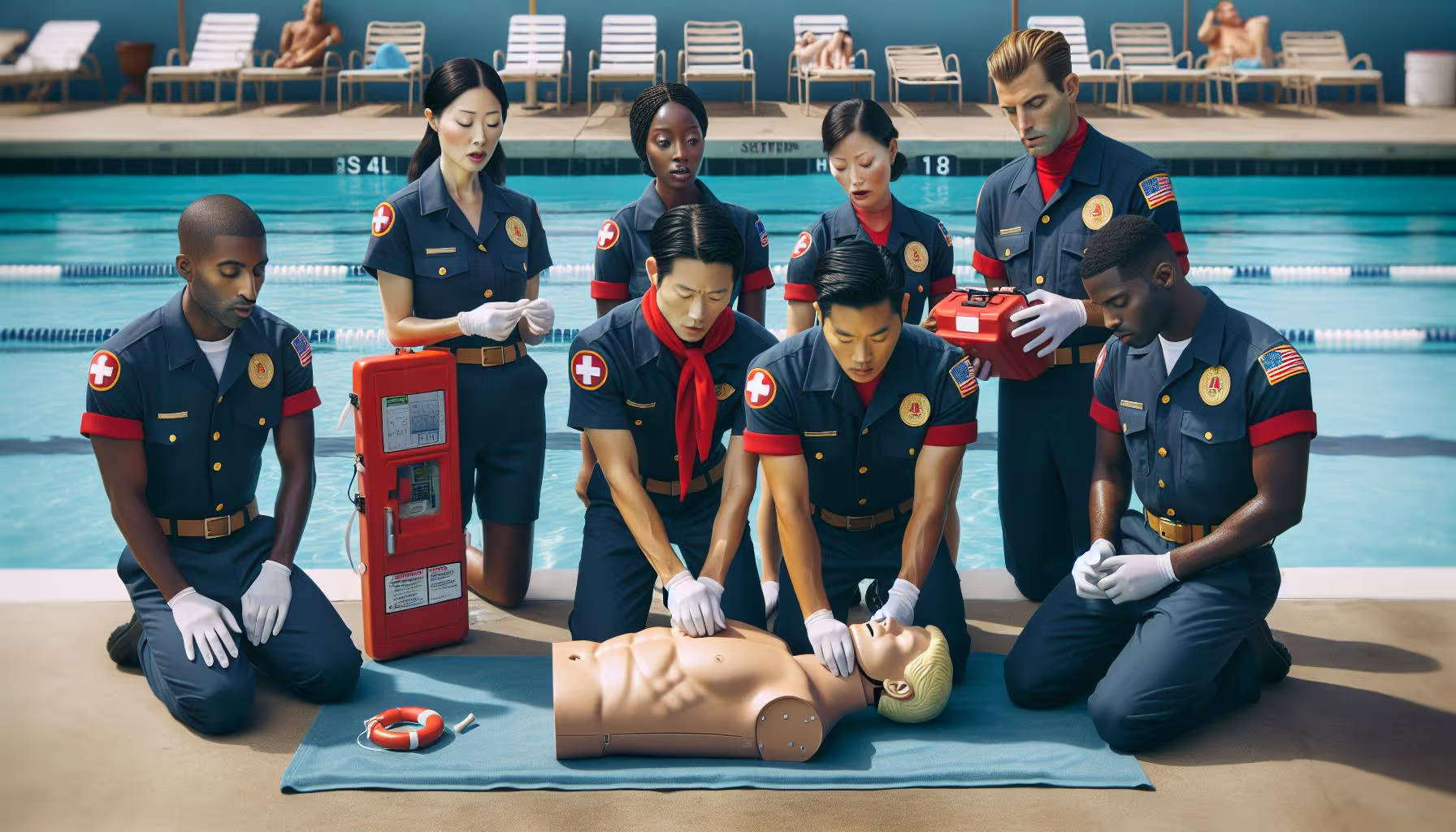Key Takeaways
- Training is Essential: Effective training in pool safety significantly reduces the risk of incidents, preparing staff to handle emergencies swiftly and confidently.
- Emergency Response Procedures: Clear, well-defined emergency protocols enable staff to act decisively in critical situations, promoting safety and reducing panic.
- Simulation Drills and Role-Playing: Engaging training techniques, such as simulation drills and role-playing scenarios, enhance muscle memory and teamwork, solidifying the staff's ability to respond in real emergencies.
- Continuous Education and Adaptation: Regular refresher courses and updates on safety regulations ensure that staff remains informed and prepared for evolving challenges in pool safety.
- Communication Strategies: Establishing effective communication methods during emergencies helps staff reassure patrons, fostering trust and promoting a culture of safety.
- Technology Utilization: Leveraging tools like field service management software streamlines training processes, tracks progress, and fosters a well-prepared team ready to tackle any pool-related incidents.
Every year, thousands of pool-related incidents occur, with over 3,500 drowning cases reported in the U.S. alone. These statistics highlight the urgent need for effective training in pool safety and emergency response. When incidents arise, having a well-prepared team can make all the difference in ensuring customer safety and minimizing risks.
We must equip our staff with the skills and confidence to handle emergencies swiftly and effectively. By implementing comprehensive training programs, we can create a culture of safety that not only protects our patrons but also instills trust in our services. Let’s explore how we can train our teams to respond to urgent pool-related situations and safeguard our community.
Importance of Training for Pool-Related Incidents
Training plays a crucial role in managing pool-related incidents. With over 3,500 drowning cases reported annually in the U.S., we face a significant responsibility to maintain safety. Effective training enables our team to respond promptly and efficiently, creating a secure environment for all.
Training empowers our staff with knowledge and skills. It builds confidence to handle emergencies, reducing panic and improving reaction times. For instance, staff trained in CPR and first aid can act decisively in critical situations. Imagine a scenario where a lifeguard jumps in to save a child struggling in the water. Their training allows them to perform tasks seamlessly, potentially saving a life.
Comprehensive training fosters a safety culture. Regular drills and workshops keep our team's skills sharp and ready for real-life emergencies. Engaging our staff in simulations—not just memorization—creates practical experience. Those imaginary scenarios we set up during training aren't just for fun; they prepare us for the unexpected. How would we react if faced with a similar situation?
Besides practical skills, training enhances teamwork. Our staff becomes a cohesive unit prepared to handle crises together. Collaborating during drills fosters communication and builds trust, making everyone feel part of the support system. Have we participated in team-building exercises lately?
Utilizing technology like field service management software can also aid training. These solutions can schedule training sessions and track progress, ensuring everyone stays updated. Technician scheduling tools provide flexibility, making it easier to arrange training around busy work schedules.
Continual education is vital. The pool industry speaks volumes about adapting to the changing safety regulations. We can help our team stay informed through regular refresher courses on industry standards. Addressing areas where our staff currently lacks knowledge can be identified through assessments, promoting community engagement in safety. Using service business software to distribute relevant resources can make information more accessible.
Incorporating automated field service solutions streamlines our training processes. These solutions can send automated reminders for scheduled drills or new training sessions. By using mobile workforce management systems, our staff can access training materials anytime. Convenient access encourages participation and allows our team to learn at their own pace.
Imagine how our service business can grow with a well-trained staff ready to tackle any situation. We inspire confidence in our customers when we handle emergencies effectively. Having a well-prepared team reflects positively on our organization and has a lasting impact on community trust.
Let’s not forget the humorous side of training. Who hasn’t had an awkward moment during a drill? Like the time someone forgot to put on their rescue tube and ended up pretending to swim like a flounder. Laughter breaks the tension and reminds us that we're all learning together.
Training isn't just a checkbox on a list. It's an investment in our staff and our patrons' safety. Being proactive about education cultivates an informed, engaged community ready to handle pool-related incidents. That commitment goes a long way in achieving our goal of providing a safe, enjoyable experience for everyone.
Key Skills for Team Training

Training our team involves developing essential skills to handle pool-related emergencies. By focusing on specific areas, we promote safety and confidence among our staff.
Emergency Response Procedures
Effective emergency response relies on well-defined procedures that our team understands thoroughly. Familiarity with protocols prepares our staff to act quickly in emergencies. We emphasize the importance of regular drills that simulate real-life scenarios, enhancing decision-making abilities. Training should cover first aid, CPR, and water rescue techniques. Staff must communicate clearly with each other during emergencies to ensure coordination.
Consider integrating field service management software to streamline training schedules and maintain accurate records of certifications. This software helps track team performance and keeps everyone updated on safety protocols. With routine assessments, we can identify skill gaps and reinforce training where needed. Our goal is to empower every team member to tackle urgent incidents confidently.
Customer Communication Strategies
Communication plays a crucial role in customer interactions during emergencies. We teach staff to remain calm and composed when addressing patrons, ensuring they feel safe and informed. Staff should practice active listening and respond to customer concerns with empathy. By establishing a clear communication strategy, we promote trust and assure patrons that their safety is a priority.
Practical Training Techniques

Effective training techniques help us equip our team with the skills needed to manage pool-related emergencies confidently. We can implement engaging and practical methods that foster readiness among staff while promoting a safe environment for our patrons.
Simulation Drills
Simulation drills create realistic scenarios that mimic actual emergencies. These drills bring urgency to training, ensuring staff practices response techniques. For instance, we could simulate a drowning incident or a chemical spill to challenge our team's abilities. Comprehensive training might include performing CPR, using rescue equipment, and communicating with emergency responders.
Offering regular drills keeps staff alert and promotes teamwork. This consistency builds muscle memory, allowing quick and effective responses when faced with real incidents. We can assess and adjust drills based on performance, ensuring every member understands their role in an emergency. Integrating Field Service Management Software helps track drill outcomes and identify areas for improvement.
Role-Playing Scenarios
Role-playing scenarios provide engaging environments where staff can practice their emergency response techniques. By acting out different roles, like lifeguards, bystanders, and even patrons, we create an immersive training atmosphere. Such scenarios highlight the importance of communication and quick decision-making.
For example, a staff member may act as an anxious patron while another practices calming and reassuring techniques. This interaction not only builds confidence but also enhances customer engagement. We can incorporate elements of humor to lighten the mood, making training enjoyable, like pretending a rubber duck is a struggling swimmer.
Using tools like Job Scheduling Software for Technicians helps us set up and organize these role-playing sessions effectively, ensuring everyone participates and learns.
These training approaches foster community among our team. They turn routine training into valuable learning experiences, empowering staff to act swiftly and effectively when it really matters.
Creating a Safety Culture

Creating a safety culture in our team takes commitment and consistent effort. It’s not just about telling staff to be safe; it’s about embedding safety into everything we do. Training sessions should focus on active participation. Our training programs can incorporate realistic simulations that mimic emergencies at the pool, letting team members practice responses in a controlled environment.
Regular drills, like fire or drowning simulations, provide hands-on experience. They enhance muscle memory so that when real emergencies happen, our response is instinctive. We can use tools like job scheduling software for technicians to coordinate these drills effectively, ensuring all staff get their turns. Does your team practice these scenarios regularly?
Communication plays a crucial role during emergencies. During our drills, we encourage clear dialogue. We can learn to use short, direct messages to quickly convey critical information. Perhaps you’ve noticed how a simple “Lifeguard down!” can sound more commanding than “Excuse me, can anyone help?”
Next, let’s employ mobile workforce management to keep everyone informed. Apps can alert team members about drill times, updates on safety procedures, or even reminders about regular maintenance checks for pool safety equipment. It's like sending a friendly nudge to remind everyone that safety is a priority.
We can boost customer engagement by helping staff learn how to communicate with patrons during emergencies. Training them to handle situations with calm and empathy reassures everyone involved. Have you ever been in a stressful situation and noticed how a friendly smile can ease tension?
Humor can also be a valuable tool in creating a comfortable learning environment. Picture this: during a drill, a lifeguard accidentally trips while demonstrating a rescue technique. Instead of gasps, we all burst into laughter. That moment lightened the mood and reminded us that while we take safety seriously, it’s okay to have fun.
Integrating service business software solutions, like field service management software, can streamline our training efforts. They help track progress, assign roles during drills, and evaluate performance, making sure we’re on our game. Who wouldn’t want to streamline our training while having more fun, right?
We also encourage feedback after each drill. This helps identify strengths and areas for improvement. Open-ended questions like, “What worked well?” or “What could we do differently next time?” foster an inclusive atmosphere where everyone feels part of the safety journey.
Creating a safety culture helps us build trust within our community. Our pool is a shared space, and we all contribute to its safety. Together, we can empower each other to handle pool-related incidents confidently. Every step we take shapes a safer environment for everyone involved.
Are we ready to take our safety practices to the next level? Let’s maintain the focus, deepen our training, and keep safety at the forefront of our daily routines.
Conclusion
By prioritizing comprehensive training and fostering a culture of safety we can empower our teams to handle pool-related emergencies with confidence. Each drill and simulation not only builds essential skills but also strengthens our communication and teamwork.
As we integrate technology and promote ongoing education we ensure that our staff remains prepared and informed. This commitment to safety not only protects our patrons but also enhances the trust our community places in us.
Let’s continue to focus on these vital practices and work together to create a safer environment for everyone.
Frequently Asked Questions
What are the main causes of pool-related incidents?
Pool-related incidents often stem from inadequate supervision, lack of safety equipment, and insufficient emergency response training. Many drowning cases occur when lifeguards or staff are unprepared to act swiftly during emergencies.
How many drowning cases occur annually in the U.S.?
Over 3,500 drowning cases are reported each year in the United States, highlighting the urgent need for effective pool safety measures and staff training to prevent these tragedies.
Why is staff training important for pool safety?
Training equips staff with the necessary skills to respond promptly to emergencies, enhancing their confidence and effectiveness. Well-trained personnel can save lives by acting decisively in critical situations.
What skills should lifeguards be trained in?
Lifeguards should master essential skills such as first aid, CPR, and water rescue techniques. Regular drills reinforce these skills, ensuring staff is prepared for real-life emergencies.
How can technology aid in pool safety training?
Technology, like field service management software, helps streamline training processes and keeps staff updated on safety regulations. It enhances communication and monitoring of training effectiveness.
What role do regular drills play in emergency preparedness?
Regular drills simulate real-life scenarios, promoting teamwork and communication among staff. They are crucial for maintaining readiness and ensuring that everyone knows their role during emergencies.
How can we foster a safety culture among staff?
To build a safety culture, prioritize commitment to safety training, encourage active participation in sessions, and provide a supportive environment for feedback and improvement.
Should staff members communicate humor during training?
Incorporating humor can create a more relaxed learning environment, making staff feel comfortable. This approach enhances engagement and helps reinforce key concepts during training.
How can we improve community engagement in pool safety?
Promoting ongoing education and training opportunities encourages community members to participate in safety initiatives. Engaged communities are better equipped to handle pool-related incidents confidently.
What are the benefits of ongoing training for pool staff?
Continuous training ensures that staff stay informed about best practices and safety protocols. It helps identify knowledge gaps, reinforces skills, and ultimately enhances the safety culture within the community.





